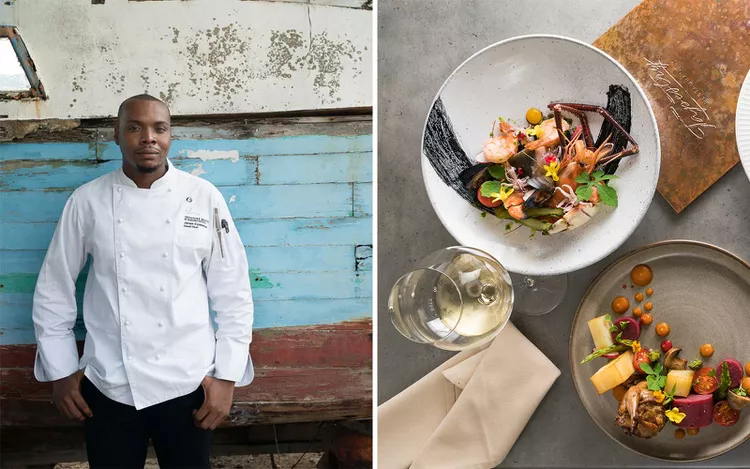“When I was a kid, my cousin and I taught ourselves to cook,” Jason Joseph told me during my recent trip to the British Commonwealth nation of Barbados. “We didn’t have money to dine out, so we would fend for ourselves.”
Their hard work paid off: the chef, who hails from Lower Carlton, now leads the kitchen at Cobblers Cove, a Relais & Châteaux resort on the western coast. I had come to check out the property’s recent renovation and to meet one of a new wave of chefs who — inspired by the food they grew up with and with an eye toward sustainability — are creating a new Bajan cuisine. Cobblers Cove is one of the few hotels of its caliber with a restaurant, Camelot, helmed by a local.
“Visitors like to know that they’re eating something fresh and traditional to the island,” continued Joseph, whose kitchen is steps from the water. Under his watch, Camelot no longer serves imported items like smoked salmon or berries. Instead, Joseph chooses smoked barracuda and a bounty of island fruits, and his breakfast buffet includes yogurt flavored with mauby, a bittersweet beverage made from tree bark that’s common in Barbados. He invited me to try his interpretation of souse — boiled pork belly, trotters, ears, and snout marinated in lime and typically served at room temperature. Joseph’s version was an elegant update, prepared with curled purple “sea cat” (as locals call octopus) and tender chunks of fresh-caught conch. Served in a sculptural white bowl, it was flecked with bits of scarlet Scotch bonnet pepper and embellished with edible flowers.
I found a similar philosophy at Tapestry, the restaurant at Treasure Beach, where 27-year-old Javon Cummins of Christ Church heads up the kitchen. Cummins made his first dish, a pan of muffins, at just six years old. “I know now that they were horrible!” he joked. “But my mother started buying me cookbooks, and from there my love for cooking just grew.” Cummins’s menu may include a velvety soup made from curried breadfruit, the starchy staple brought to the Caribbean in the 18th century to feed the enslaved population, or an open-faced sandwich of flying fish on focaccia, which has its roots in the fish “cutter” (Bajan for sandwich) that’s considered an unofficial national dish.
This Island Leaves Travelers More Satisfied Than Any Other Destination
I tasted another cutter at ECO Lifestyle + Lodge, this one piled with roasted eggplant. Opened in 2018, the 10-room lodge on the rugged Atlantic coast is centered around wellness and sustainability. There, St. James-born chef Alisha Stoute serves mostly seafood and plant-based dishes. The 33-year-old, Cordon Bleu-trained Stoute admits that consistency of ingredients is a challenge — produce grown on Barbados has historically been limited not only by the island’s coral soil but also by a lack of resources. Still, her goal is “always local.” Luckily, fishermen and farmers are increasingly able to deliver ingredients (octopus, sea urchin, purslane) to her door daily — and soon, more will start arriving from ECO’s own recently planted plot.
Chef Nathan Crichlow needs only to step outside his kitchen to reap a Bajan bounty. His breakfast-and-lunch restaurant, the Chrysalis Café, is at the 108-acre PEG Farm & Nature Reserve, which grows organic produce and raises free-range cows, chickens, and pigs. Established in 2013 by Paul Bourne, the farm’s mission — People, Environment, Growth — includes restoring land depleted by centuries of sugarcane production and supplying the community with nutrient-rich food. Crichlow enjoys first dibs on PEG’s harvest. His menu at the Chrysalis offers twists on familiar flavors, like a roast chicken bowl with fried plantains and garlic-chive dressing or a vegan hash of breadfruit, okra, curried eggplant, and wilted sweet-potato leaves.
“I wish people would come and taste the real Barbados,” Crichlow told me on my last day there. “Don’t come here to eat Yorkshire pudding and Dover sole. You should be enjoying mahi-mahi, flying fish, and barracuda.”
As I savored my pan-seared amberjack, I had to agree.
A Barbados Culinary Checklist
No visit to Barbados would be complete without a meal at The Cliff, where British chef Paul Owens helms the kitchen — it’s been a star of the dining scene since it opened in 1995.
Also worth a stop is La Cabane, a French-owned beach bar with a great wine list and live music.
Barbados’s most famous cutter has been served for more than half a century at nearby Pebbles Beach, where Cuz, of Cuz’s Fish Shack, turns out his $5 marlin sandwiches — each fried up on a single hot plate in his tiny wooden stall.
Be sure to head to Oistins, a fishing town on the southern coast, for the legendary Friday night Oistins Fish Fry — there are more than 30 stalls to choose from, including standout Pat’s Place, serving grilled mahi-mahi and macaroni pie since 2003.
Visit Mount Gay Rum — Barbados claims to be the birthplace of the spirit — to taste the work of Trudiann Branker, the island’s first female master blender.
Barbados is also known for its fabulous Food & Rum Festival, the perfect event to build a trip around.
A version of this story first appeared in the February 2020 issue of GoTravelDaily under the headline Talent Takes Root. Visit Barbados provided support for the reporting of this story.





